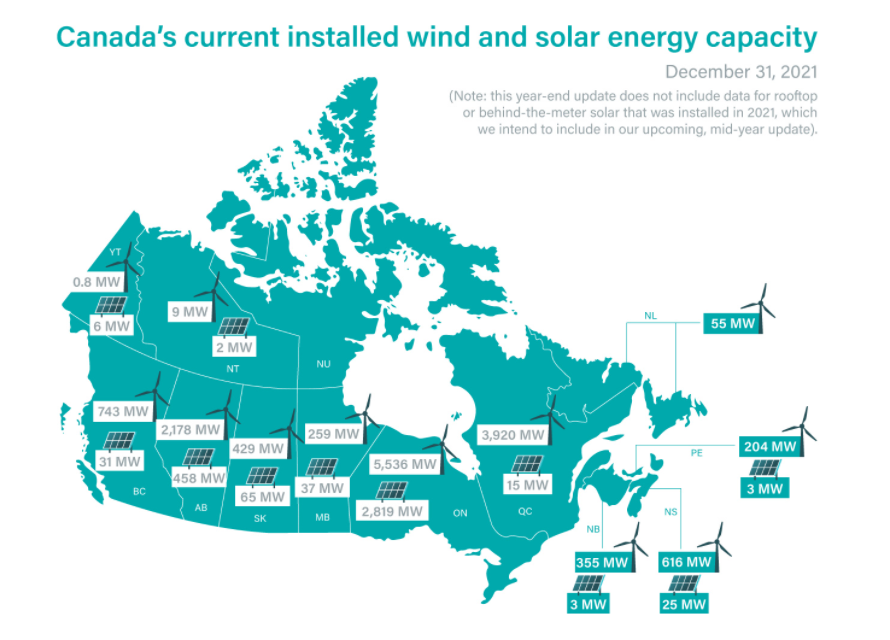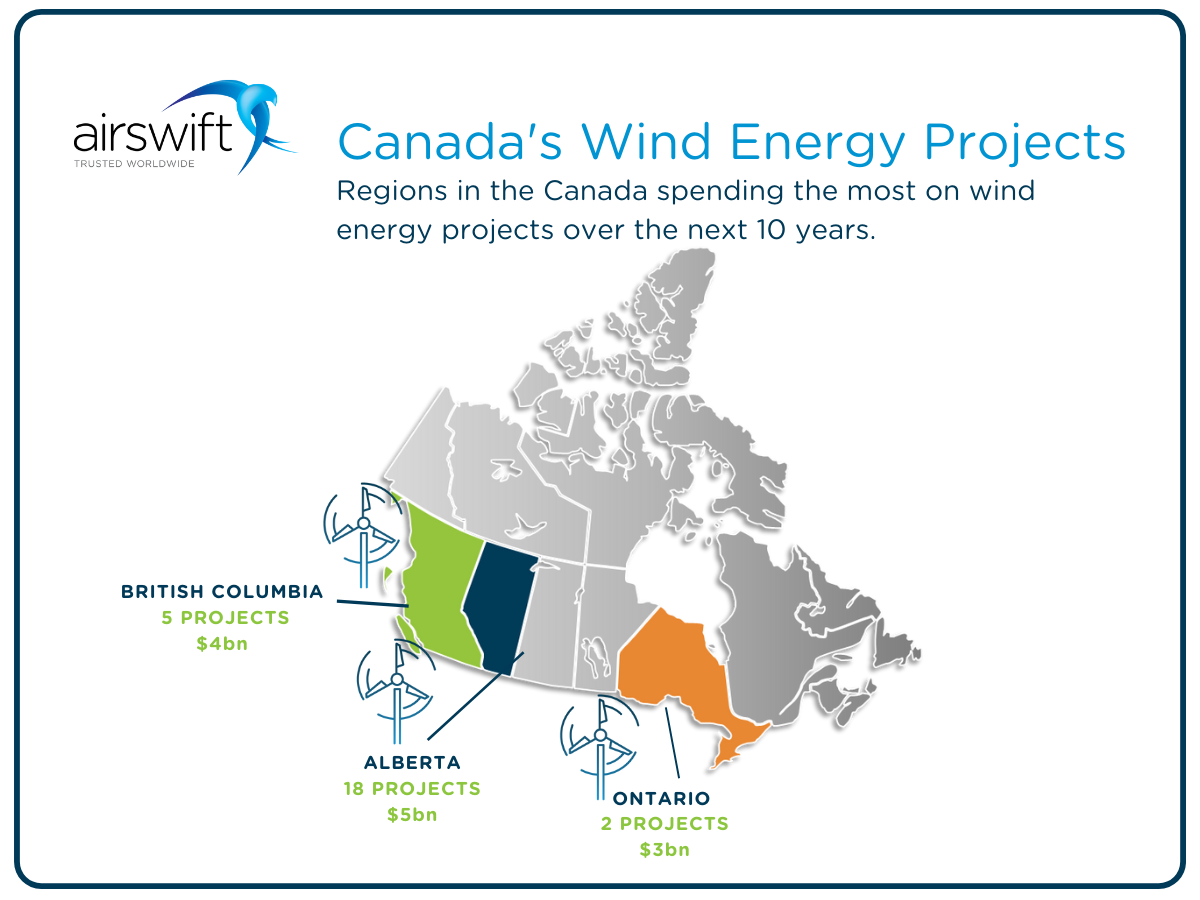
By
Nana Terra
August 19, 2022
Updated
January 21, 2025
Wind energy plays a crucial role in reaching global net-zero carbon emissions. We need to install around 180 GW per year to keep global warming at 1.5°C, according to the Global Wind Report 2021.
So, countries worldwide are entering the technological and environmental race to achieve these goals. Canada is one of the world leaders in producing and using renewable power due to its diversified geography with hydro, biomass, wind, and solar energy sources.
But, what can we expect from the Canadian wind energy industry?
Although Canada is new to exploring its vast wind energy resources, the country has grown fast in the sector, and it is already one of the world’s largest producers. At the end of 2021, the region had approximately 14,304MW of installed wind energy capacity.
Wind energy in Canada accounts for 3.5 per cent of electricity generation, being the second most important renewable energy source in the region. The provincial leaders in wind power capacity are Ontario, Quebec, and Alberta.
Canada is also investing heavily in new energy storage technologies to support clean energy.

Market trends to 2023 in Canada
Top 5 wind energy projects in Canada
According to the Canadian Renewable Energy Association, Canada has 317 wind energy projects producing power across the country. The largest wind farm is Black Spring Ridge, located in Vulcan County, Alberta, with 166 wind turbines.
Thirty-nine onshore and offshore wind power projects are planned for the next ten years, with a total project value of $16bn. Read about the top 5 projects.
- Sharp Hills Onshore Wind Farm
- Wild Rose Onshore Wind Farm
- Wolfe Island Shoals Offshore Wind Farm
- Queen Charlotte Islands Offshore Wind Farm
- Yarmouth Offshore Wind Farm

Figure 1: The regions in Canada spending the most on wind power projects over the next 10 years are Alberta, British Columbia, and Ontario.
Sharp Hills Onshore Wind Farm
This wind farm will have up to 300MW in Special Areas 3 and 4 near the Sedalia and New Bridgen Hamlets in Alberta. The wind generated is enough to power about 160,000 average Alberta Province homes.
The project will support around 300 construction jobs and create up to 15 to 20 permanent local jobs during the project’s life. Operated by EDP Renewables, the wind farm comprises 71 Enercon E138 4.2MW wind turbines.
The power generated by the project will be transmitted to the 240 kV ATCO transmission line and will also include a new substation, Sedalia 363S. The project is scheduled for completion in 2023.
Around 50 supportive families representing 47,000 acres take part in the project. Clean and usable energy will help the region grow. The annual carbon offset of Sharp Hills Wind Farm is equal to taking more than 175,000 cars off the road.
Wild Rose Onshore Wind Farm
Operated by NaturEner, this project will have an installed capacity of up to 409MW in Alberta. The construction happens in two phases: Wind Rose 1 and Wind Rose 2.- Wild Rose 1 is a construction of a 217.6MW wind power project with 70 Alstom ECO110 3MW turbines, access roads, and underground interconnections.
- Wild Rose 2 is a construction of a 192MW wind power project with 63 Alstom ECO110 3MW turbines.
With an investment of $630 million, Wild Rose Onshore Wind Farm is in the development stage, and it is expected to start in 2023.
Wolfe Island Shoals Offshore Wind Farm
Located in Lake Ontario, a Windstream's Wolfe Island Shoals project is a planned 300MW offshore wind farm. The turbines will be built on semi-floating gravity bed foundations (also known as 'GBFs').
These GBFs have been specially designed by leading engineers whose technology is used in offshore wind turbine installations around the world.
Wolfe Island Shoals Offshore Wind Farm is on hold, waiting for responses from the government to continue the project.
Queen Charlotte Islands Offshore Wind Farm
This project is a development of an offshore wind farm comprising up to 110 turbines with a combined output of 396MW.
It is located in waters of around 20m depth on the Dogfish Banks of the Hecate Strait near the Queen Charlotte Islands. The project will generate 1,750MW of electricity when fully operational.
Yarmouth Offshore Wind Farm
This project is a 1GW offshore wind farm 20km off the coast of Yarmouth, Nova Scotia, with a depth range of 44m-60m and 10m/s wind resource.
Yarmouth Offshore Wind Farm will export power to New England. It will be done via the Can-Am link, a 322km subsea cable to the United States.
With an investment of $4bn and more than 120 turbines, the project is in planning. The expectation is to start operating in 2025.
The turbines will sit on a gravity base in shallow waters of less than 30m. It will be outside major shipping lanes and commercial fishing grounds and will be built in phases. The company operator is Beothuk Energy.
Airswift can help you deliver wind projects
With over 60 offices worldwide, 1,000 employees, and 9,000 contractors, we have successfully placed permanent and contract personnel across various wind energy disciplines. Airswift is committed to supporting the energy transition and is a world-leading green recruitment company.
Our offices in Calgary, St. John's, Halifax, Toronto, and London connect international talent to the most significant wind energy projects. Our dedicated consultants can support clients throughout the whole onshore and offshore wind project lifecycle.
Want more insight into talent trends in the renewable energy industry? Click the link below to download our latest whitepaper.

Want to know more about clean energy recruitment and top green projects in Canada? Read also:

